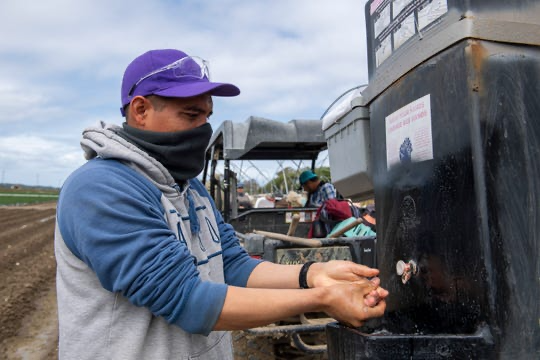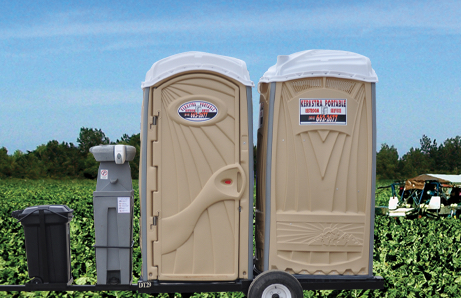
It goes without saying that the country finds itself navigating unprecedented circumstances during the coronavirus disease (COVID-19) pandemic outbreak. Every aspect of our daily lives has been impacted and no more so than considering the safety, health and well-being of our agricultural workforce. Since the US Department of Homeland Security deemed agriculture an essential industry back in March, growers across the country have continued forging ahead in producing the safest possible food supply. That work has included a variety of challenges, the least of which is how best to prevent the spread of COVID-19 on the farm. Agricultural operations have a number of aspects of employee safety to consider in an effort to minimize this ongoing health risk.
COVID-19 Precautions in Agriculture
There are a variety of precautions to evaluate and implement on each farm to ensure the safety of farm workers during the COVID-19 pandemic. Owners and management need to consider the following:
Communicating with Workers
Perhaps most essential of all is the need for daily communication with workers. The misinformation available through social media and other outlets has led to critical misunderstanding around how the virus is spread and what steps both employers and the individual employees themselves need to take to minimize risk. As such, it is critical that employees receive information including:
- Details on the signs and symptoms of COVID-19 and how to minimize the spread of germs
- Videos in English and Spanish are available here: http://www.agsafe.org/covid-19-resources/webinars-and-videos/
- Tell workers what to do if they feel sick or have a sick family member at home
- Recommendation from the CDC in English: http://www.agsafe.org/cms/wp-content/uploads/2020/03/CDC-Steps-to-Prevent-the-Spread-of-COVID-19.pdf
- Recommendation from the CDC in Spanish: http://www.agsafe.org/cms/wp-content/uploads/2020/03/CDC-Steps-to-Prevent-the-Spread-of-COVID-19_Spanish.pdf
- Remind workers about what steps you are taking to keep them protected and identify who (supervisor, HR or Safety Manager, owner) they should come to if they have questions or concerns.
Social Distancing
- During the start of the shift, breaks and lunch, keep workers at least six feet apart.
- Provide additional seating, such as plastic or folding chairs, to ensure workers are off the ground.
- Stagger breaks and lunch if additional seating is not available.
- Stagger meetings and trainings at the start and end of the shift if additional seating is not available.
- When working, space workers out to provide distance between them:
- One row separating them when planting, pruning, thinning, harvesting, and other work in orchards.
Drinking Water for the Crew
- Assign an employee to serve drinking water to crew members from the communal water receptacle.
- Ensure the worker serving the water has proper PPE (disposal gloves, face mask or covering).
- Sanitize the spigot after filling disposable cups each break.
- Sanitize the spigot if it comes in contact with a reusable water container drinking area (example: mouth of a water bottle.)

Portable Restrooms and Handwashing
- Assign an employee to sanitize portable restrooms (door handles, locks, toilet seats) and handwashing facilities (spigot, soap dispenser, paper towel dispenser) frequently during the day.
- Ensure the worker has proper PPE (disposal gloves, face mask or covering).
- Provide sanitizing product for employees to sanitize portable restrooms (door handles, locks, toilet seats) and handwashing facilities (spigot, soap dispenser, paper towel dispenser) after each use.
- Ensure workers are trained in how to properly sanitize and the expectation that they follow this procedure is communicated frequently.
- Assign a supervisory employee to monitor compliance.
Worker Transportation
- If you provide a company vehicle or truck to your workers, ensure that those vehicles are being cleaned and sanitized on the inside and outside regularly, ideally once a day.
- If it is essential to use transportation, such as a van or bus, to transport your workers:
- Sanitize at least twice a day (following employee pick-up and drop-off) all points of contact – seats, seat belts, knobs, doors, handles, buttons – that employees touch.
- Ensure ample ventilation and airflow inside the vehicle.
- If possible, seat workers spaced at least six feet apart.
- Consider additional trips to allow seating spacing of workers.
- Assign seating so if a worker becomes ill, it is easy to identify those in close proximity and take the appropriate next steps around informing them, as well asking them to stay home from work for 14 days.
Sanitizing Equipment and Tools
- More frequent sanitation of all equipment and tools is critical. Ensure teams already responsible for cleaning do so more frequently, at a minimum daily. Do not forget the following items, which can be overlooked:
- Tractors, forklifts, ATVs, UTVs – seats, seat belts, knobs, doors, handles, buttons.
- Areas of congregation and meeting, both inside and outside – start of shift, tailgate training, breaks, lunch and end of shift.
- Chairs, shade trailers, buckets
- Refrigerators, coolers, water jugs
- Vending machines
- Garbage cans
- Bottles and containers used daily
- Employee equipment and tools
- Bins
- Hand tools
- Garbage cans
The continued safety and health of our workers is paramount. It is critical that growers maintain their vigilance around year-round issues, as well as consider the unique circumstances now impacting our industry as we navigate safety during the COVID-19 pandemic.
For more information about worker safety, human resources, labor relations, pesticide safety or food safety issues, please visit www.agsafe.org, call (209) 526-4400 or email safeinfo@agsafe.org. AgSafe is a 501c3 nonprofit providing training, education, outreach and tools in the areas of safety, labor relations, food safety and human resources for the food and farming industries. Since 1991, AgSafe has educated over 85,000 employers, supervisors, and workers about these critical issues.















